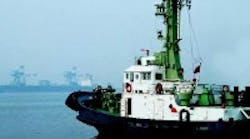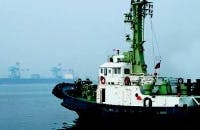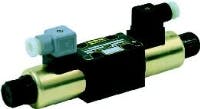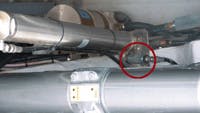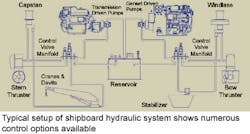Hydraulic technology has long been the standard for power-demanding applications on both commercial and naval ships. The components are ideal for marine use, because they are robust and will handle a wide variety of environments. In addition, the high power density and ability to control loads with relatively simple controls make it an ideal choice for shipboard duty. The range of applications includes steering systems, stabilizers, cranes, hoists, davits, hatch lifts, mast control, and winches.
As the face of electronic technology changed dramatically in the past two decades, it led to new refinements in the design of hydraulic valves — refinements that resulted in a dramatic improvement in the ability to control loads.
The marriage of electronics to traditional hydraulic components made hydraulics an even more attractive power source choice for the commercial shipping and yachting world.
Marine guidance systems
Sophisticated computer systems linked to Global Positioning System (GPS) and radar systems guide many of the ships at sea today. The high cost of early systems limited their use to commercial ships and high-end luxury yachts. Today, the technology is very affordable and can found on pleasure boats smaller than 30 ft. Autopilot systems for small yachts allow the captain to make course changes at the helm or anywhere on the vessel with a handheld remote control.
Many of the control systems aboard ship operate with a programmable logic controller (PLC). Reliability is a key concern in the marine world, as well as the industrial world. PLCs have an exemplary record for dependability, with over 2 billion in operation across the globe. Many of today's PLC-based industrial systems are being replaced with computers, and the same holds true in marine applications. The shipboard management systems, whether they are PLCs or computers, can also manage the hydraulic control systems.
Today's hydraulic systems are such that they can be easily integrated into the shipboard computer systems to enhance the control of the simplest of operations and offer more sophisticated control of the hydraulic components anywhere on the vessel. In addition, they can also provide maintenance and safety alerts if a problem is imminent. Realtime information, such as oil temperature, contaminant concentrations, reservoir level, and the condition of the oil filters, are all available at the helm station. For the pleasure boat captain, this means comfort at sea and dependability. For the commercial ship captain, it translates into maximum control, better operating efficiency, and dependability.
Communication systems
Modern marine control systems employ components that operate in the NMEA (National Marine Electronics Assn.) 2000 standard, which sets the requirements of a serial data communications network to interconnect marine electronic equipment. This serial bus system, also referred to as CAN, Controller Area Network, provides communication between the master controller and devices on the system identified as nodes or slaves , through a single lightweight cable. The cable carries input signals from control devices or monitoring devices to the controller via the Rx line. Then, based on the internal program, command signals to a variety of devices such as steering systems, engine controls, pumps controls, proportional or discrete position valves, signal lights, and audible alarms are carried via the Tx line.
Serial bus systems have been used with hydraulic systems in the industrial world for many years. They are easy to expand — a new device can be added to the system anywhere on the ship. The controller is then programmed to accept the addition, note its address, and then integrate the function into the main program.
Power density
When compared to electromechanical actuators, the horsepower-to-weight ratio for hydraulic actuators is quite high — typically 8:1. For instance, a 20 hp variable speed electric motor would weigh well over 150 lb, while the hydraulic counterpart would weigh less than 20 lb. The smaller size of the motors is especially important because it makes them easier to install — it frees up space, and reduces the weight of the vessel thereby adding to fuel efficiency. Windlasses, bow thrusters, and capstans all rely on motor actuation. By operating at 3000 psi, the hydraulic actuators can be reduced in size even more than their predecessors. The result is that less flow is required thereby reducing the size of the pumps, control valves, and associated hydraulic piping.
Better control through proportional valves
The preponderance of valves found aboard commercial ships are lever-operated directional control valves — usually found in multi-station banks to handle two or more operations. When applications require remote control, solenoid operated directional valves are employed and the valves usually operate with 12- or 24-V DC power. These valves are discrete position devices with no control of flow. Actuator velocity control is provided by inline flow controls. When a greater degree of control is required, the proportional control valve is selected.
Proportional directional control valves yield a variable amount of flow in response to a variable signal to the valve amplifier. Amplifiers can accept one of two types of signals — a voltage signal from 0 to ±10-V DC, or a 0 to ±20 ma current signal. Command signals come from sources such as joystick, a PLC, or computer. The amplifier then generates a variable current output to the valve solenoids using pulse width modulation circuitry. The ability to infinitely vary the flow to an actuator gives the operator the ultimate in controllability for every application.
Another major benefit of the proportional control valve is the elimination of shock and vibration through the use of ramp controls on the valve drivers. This option slows down the shift of the valve to allow the actuator to start smoothly and come to a smooth stop. Valve actuation which normally takes place in 20 to 30 msec can be slowed down to as much as 5 sec when necessary.
Large booms or cranes with heavy loads are structures that have very low natural frequencies. Abrupt valve shifts result in abrupt actuator movement — movement that can excite the natural frequency of the structure and actuator causing the load to go unstable. The ramp control of the proportional valve can be adjusted to slow down the shift of the control valve. This action decreases the rate of acceleration and deceleration of the load thereby reducing the chance of having the load go unstable.
Operational integrity can be further-enhanced with the addition of sensors that measure the load, the angle, and the length of extension by the moving structural member. The electronic controller, be it a computer or programmable logic controller, reads this information and then automatically limits the speed at which an operator can move the load — thus ensuring safe operation.
A popular proportional valve application is the roll stabilization system. Large fins are mounted below the water line and they operate with hydraulic cylinders or rotary actuators to counteract the tendency of the vessel to roll. Electronic ride control systems monitor the movement of the ship and then send signalsto the proportional valves to control the fins. The movement of the fin applying an equal and opposite righting moment in the proper phase and proportion is smooth and consistent. These systems are now installed on vessels as small as 30 ft. An additional benefit is the fuel savings. Ships that roll while under way require more rudder corrections to stay on course — constant rudder movement means more drag and less fuel efficiency.
Power savings
In the past, fixed-displacement pumps were the mainstay of the shipboard hydraulic system. Modern systems now employ variable displacement pumps with electronic control options. The master control system can adjust the pump pressure and flow to match the application, thereby resulting in better control of the actuator and a savings in energy usage. Many fixed-displacement systems are cycled on and off on demand. Others operate continuously in an unloaded mode relying on unloading valves. The newer pressure compensated variable volume pump systems can be operated continuously in a standby mode ready to deliver power on demand instantly. There is also a savings in the control power required to operate the newer hydraulic valves. Discrete position solenoid operated valves now operate with much lower power — a mere 8 W instead of 27 W are required for a typical 12-gpm valve.
Redundancy
Redundancy is another concern in the marine world and it is easily achieved with hydraulics. The hydraulic pump is the heart of the system, and the addition of a second standby pump is easily facilitated on vessels with one or two engines. Both pumps are connected to the same main pressure line with isolation valves so that either can be operated at any time. In some cases, electric motors are chosen to drive the pumps with the installation to a common pressure line. Control valves can also be added for redundancy with each valve connected in parallel to a single actuator.
Robust componentry
Zero leak is no longer just a buzz phrase in the world of hydraulics, it's a reality. Modern hydraulic piping systems employ O-ring faceseal type tubing connections to provide the utmost in operational integrity. The days of pipe thread connections have long since past, and all components are available with SAE straight thread O-ring ports to ensure leak-free operation for the life of the system.
Hydraulic technology has excelled in harsh land-based applications, such as mobile construction equipment, foundries, and mining. Hydraulic system components also have a proven record of longevity in the harshest of marine environments. Liberal use of stainless steel material and two-part epoxy coatings for other exposed surfaces provide a great deal of protection against corrosion.
Hydraulics can be found operating continuously on workboats harvesting crab off the wintry coast of Alaska, on icebreakers pounding through the frozen Great Lakes to keep shipping lanes open, and on Navy aircraft carriers operating in the North Atlantic.
Hydraulic technology also touches the land-based support systems for the marine industry in the form of cranes, hoists, marine travel lifts to launch and haul yachts. In addition, a myriad of stationary and mobile forklifts for smaller boats can be found at harborside. These applications while not as sophisticated as some aboard ship, still rely on reliable hydraulic muscle.
Summary
All the benefits of hydraulics — the functionality, the dependability, the system integrity, and the ability perform in harsh environments — demonstrate why the marine industry has embraced hydraulics. Hydraulic technology will continue to evolve and be on board the ships of the future to the delight and comfort of the captain, crew, and passengers.
Flow fuses provide extra safety
When the line is repaired or replaced, the valve will automatically reset to the normal operating condition. The valve is adjustable for a wide range of flow in a given port size, and once adjusted, tightening a simple setscrew can lock it. It can be placed in any hydraulic line to limit the loss of fluid should a failure occur. This valve is especially valuable for marine applications, where contamination of the environment of great concern.
